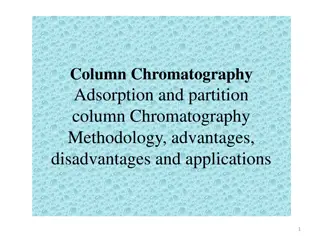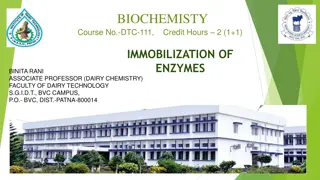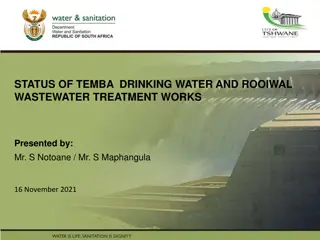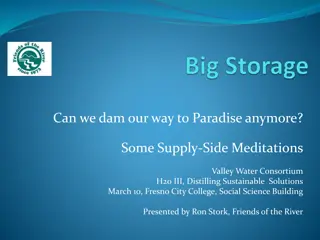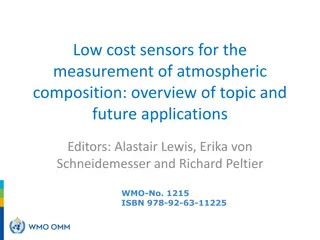Sawdust as a Low-Cost Adsorbent for Water Treatment
Sawdust, a renewable natural resource, has been studied for its effectiveness as an adsorbent for removing contaminants from water. It contains cellulose, hemicellulose, lignin, and other components that aid in adsorption. Research indicates its suitability for removing dyes, toxic salts, and heavy metals from wastewater, making it a cost-effective and eco-friendly option for water treatment applications.
Download Presentation

Please find below an Image/Link to download the presentation.
The content on the website is provided AS IS for your information and personal use only. It may not be sold, licensed, or shared on other websites without obtaining consent from the author. Download presentation by click this link. If you encounter any issues during the download, it is possible that the publisher has removed the file from their server.
E N D
Presentation Transcript
Minia University Faculty of Engineering Chemical Engineering Department Course Title: Unit Operation II Course Code: CHE 321 Third Year Course Coordinator: Prof.Dr.Mohammad Shawky Lecture No. 11
Types of Adsorbents New Adsorbents Agricultural wastes Industrial wastes
Types of Adsorbents Agricultural Wastes Bagasse pith Saw dust Maiza cob
Types of Adsorbents Agricultural wastes Bagasse pith Saw dust Maiza cob
II. New Adsorbents (Low - Cost Adsorbents) 1.Saw dust Sawdust is an important worldwide renewable natural resource. Forests comprise approximately one-third of the earth s total land mass. There are an estimated 12,000 species of trees, each producing a characteristic type of sawdust. Consequently, there is considerable variation in the species of trees harvested in different countries and, in some cases in different parts of a single country.
II. New Adsorbents (Low - Cost Adsorbents) 1.Saw dust The terms hard wood and soft wood refer to the species, and not necessarily the hardness of the sawdust. Although hard wood generally are denser than soft wood, the density varies considerably within each group, and the hardness of the two groups overlaps somewhat (Fengel & Wegener 1984). Sawdust consist of cellulose (40-45%), hemicellulose (20-30%), lignin (20-30%), extractives (1-10%), and inorganic (1%) (Eman 1994).
II. New Adsorbents (Low - Cost Adsorbents) 1.Saw dust Suitability of using sawdust as a natural adsorbent for removal of basic dyestuffs from simulated wastewater was studied (El-Geundi 1983). The kinetic adsorption as well as theadsorption isotherms for the removal of dyestuffs by sawdust has been studied by Asfour et al. (1985).Bryant et al. (1992) showed adsorption of Cu and hexavalent chromium Cr (VI) by sawdust to take place primarily on components such as lignin or tannin rather than onto the cellulose backbone of the sawdust.
II. New Adsorbents (Low - Cost Adsorbents) 1.Saw dust Sawdust has been found to be an effective adsorbent of dyes, toxic salts and oil from water (Nag 1995). Several types of barks have been used to remove heavy metal ions from aqueous solution (Gaballah & Kibertus 1998; Bailey et al. 1999). The adsorption mechanisms can be explained by the presence of several interactions, such as complexation, ion-exchange due to a surface ionization, and hydrogen bonds
II. New Adsorbents (Low - Cost Adsorbents) 1.Saw dust Ho and McKay (1998) showed that the adsorption capacity of basic dye is much higher than that of acid dye because of the ionic charges on the dyes and the ionic character of sawdust.
II. New Adsorbents (Low - Cost Adsorbents) 1.Saw dust Sawdust is an effective adsorbent because of its high tannin content (Bailey et al. 1999). Morais et al. (1999) studied adsorption of Remazol BB onto eucalyptus bark from Eucalyptus globules.The polyhydroxy polyphenolic groups of tannin are thought to be the active species in the adsorption process.
II. New Adsorbents (Low - Cost Adsorbents) 1.Saw dust Parallel sorption tests, under similar conditions, carried out with a commercial activated carbon and with bark, showed for the latter an adsorption capacity about half that of the former. The authors concluded that there are promising perspectives for the utilization of eucalyptus bark as sorbent on an industrial scale.
II. New Adsorbents (Low - Cost Adsorbents) 1. Saw dust Removal of Basic Violet 3 and Basic Green 4 from aqueous solution using sawdust was investigated by Khattri & Singh (2000); they also noted that the adsorption capacity of Neem sawdust was highly concentration dependent. Sawdust has been used to remove cadmium and nickel (Basso et al. 2002). The role of sawdust materials in the removal of pollutants from aqueous solutions has been reviewed recently (Shukla et al. 2002).
II. New Adsorbents (Low - Cost Adsorbents) 1. Saw dust Sawdust contains various organic compounds (lignin, cellulose and hemicellulose) with polyphenolic groups that might be useful for binding dyes through different mechanisms. Sawdust has been a source of adsorbent materials both in its natural and modified state.
II. New Adsorbents (Low - Cost Adsorbents) 1. Saw dust Effective adsorbent is developed from sawdust, was studied for removing of Crystal Violet from its aqueous solution, it is seen that 341mg of the dye can be removed using 1 g of adsorbent at 298 K, effect of particle size of adsorbent, initial concentration of dye, temperature and adsorbent amount were studied. Two-resistance mass transfer model, which include a film mass transfer coefficient, Kf and an internal effective diffusivity, Dp, is used to interpret the adsorption kinetic data (Basu 2004).
II. New Adsorbents (Low - Cost Adsorbents) 1. Saw dust The adsorption of copper (II) ions from aqueous solution onto sawdust from different kinds of woods has been studied. The results of batch studies showed that Kraft lignin was a good adsorbent over the whole concentration range studied, hard wood sawdust was good when the Cu (II) ion concentration in the aqueous solution was high, while soft wood sawdust and pulp were good for the adsorption of Cu (II) ions when the latter were present over the low concentration range (Sciban & Klasnja 2004).
II. New Adsorbents (Low - Cost Adsorbents) 1. Saw dust Sawdust has proven to be a promising effective material for the removal of dyes from wastewaters (Garg et al. 2004, zacar & Sengil 2005). Thermal analysis of some materials obtained from spruce bark, after retention of some dyes frequently used in dying process was studied; these materials obtained by dye retention exhibit a particular thermal behavior which is different from that of the blank sample (spruce bark).
II. New Adsorbents (Low - Cost Adsorbents) 1. Saw dust The characteristic temperatures, weight losses, the residue remaining after thermo-oxidative degradation as well as activation energies of the significant thermo-destruction stages, together with the thermal quantities calculated from DTA data have been investigated. The obtained results made evident that, under optimal retention conditions, spruce bark shows the highest retention capacity for the Basic Blue dye followed by Direct Brown 95 (Odochian et al. 2005).
II. New Adsorbents (Low - Cost Adsorbents) 1. Saw dust The batch adsorption of Methylen Blue onto cedar sawdust was studied, in order to explore their potential use as low- cost adsorbent for wastewater dye removal. Experimental data obtained were modeled well by Langmuir isotherm with maximum adsorption capacity of 142.36 mg/g. Analysis of adsorption kinetic results indicated that both film- and particle- diffusion are effective adsorption mechanisms, the extent of the dye removal decreased with increasing the solution temperature, optimum pH value for dye adsorption pH =7 for both adsorbents (Hamdaoui 2005).
II. New Adsorbents (Low - Cost Adsorbents) 1. Saw dust The batch and column kinetics of Methylen Blue and Basic Red 22 adsorption on acid - hydrolyzed beach sawdust were investigated. Removal of hemicellulose during sulphuric acid treatment, resulting in the opening of lignocellulosic structure and increasing of the BET surface area. Activation of the material's surface owing to an increase in the number of dye binding sites (Sirdiras & Batzias 2006).
II. New Adsorbents (Low - Cost Adsorbents) 1. Saw dust It is suggested that sawdust and other biodegradable lignocellulosic vegetable product such as cotton wool, sugar cane, paper, etc., may prove very economical, technically feasible and environmentally acceptable for application in oil spill cleanup technology (Lisperguer et al. 2007).
II. New Adsorbents (Low - Cost Adsorbents) 1. Saw dust The capacity of juniper wood (JW) and bark (JB) to adsorb cadmium (Cd) from aqueous solutions at different pH values was compared. Adsorption behavior was characterized through adsorption kinetics, adsorption isotherms, and adsorption edge experiments. Results from kinetics and isotherm experiments showed that JB had 3 4 times higher adsorption capacity for Cd than JW.
II. New Adsorbents (Low - Cost Adsorbents) 1. Saw dust In addition to higher capacity, JB exhibited a higher strength of adsorption and faster uptake kinetics compared to JW. For both these adsorbents, increasing Cd adsorption with increasing solution pH in the range of 2 6 suggests that surface carboxyl groups (RCOOH) might be involved in interaction with Cd. The higher Ca content in JB (15 times more) and the surface RCOOH concentration (2.5 times more) can be attributed to the observed differences in Cd adsorption behavior between the two lignocellulosic adsorbents (Karthikeyan et al. 2007).


